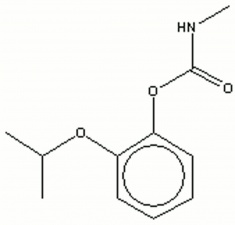Difference between revisions of "Baygon"
Jump to navigation
Jump to search
(→Risks) |
|||
| Line 13: | Line 13: | ||
Decomposes to form methyl isocyanate. May stain fabrics, plastics, paper and rubber. | Decomposes to form methyl isocyanate. May stain fabrics, plastics, paper and rubber. | ||
| − | [ | + | Bayer: [https://allpest.com/labels/Baygon-Bait-2-pct-msds.pdf MSDS] |
[[[SliderGallery rightalign|propoxurir.jpg~FTIR|propoxurstructure2.jpg~Chemical structure]]] | [[[SliderGallery rightalign|propoxurir.jpg~FTIR|propoxurstructure2.jpg~Chemical structure]]] | ||
Revision as of 11:46, 14 August 2020
Description
[Johnson] A registered trademark for a series of Insecticide containing either Propoxur or a Pyrethrin derivative.
Synonyms and Related Terms
propoxur; PHC; 2-isopropoxyphenyl methylcarbamate; o-IMPC
Risks
Toxic by ingestion, inhalation and skin absorption. LD50=90-128 mg/kg
Decomposes to form methyl isocyanate. May stain fabrics, plastics, paper and rubber.
Bayer: MSDS
Physical and Chemical Properties
| Composition | (CH3)2CHOC6H4OOCNHCH3 |
|---|---|
| CAS | 114-26-1 |
| Melting Point | 91.5 |
| Molecular Weight | mol. wt. = 209.2 |
Resources and Citations
- Baygon: Website
- Richard S. Lewis, Hawley's Condensed Chemical Dictionary, Van Nostrand Reinhold, New York, 10th ed., 1993
- Lynda A. Zycherman, J.Richard Schrock, A Guide to Museum Pest Control, FAIC and Association of Systematics Collections, Washington DC, 1988


